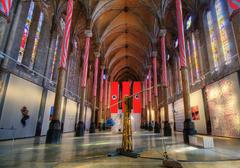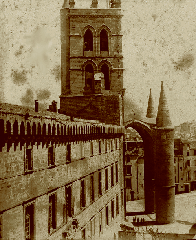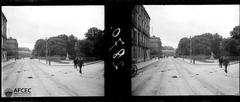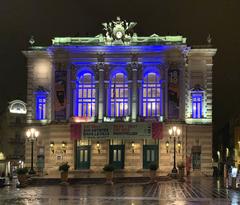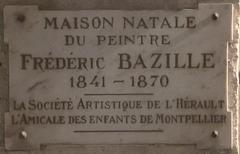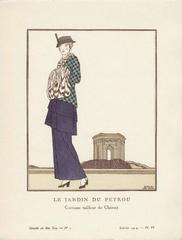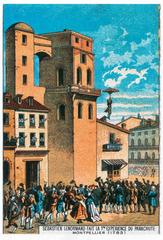Old Montpellier Museum: Visiting Hours, Tickets, and Historical Sites in Montpellier
Date: 03/07/2025
Introduction
Nestled in the heart of Montpellier’s historic Écusson district, the Old Montpellier Museum (Musée du Vieux Montpellier) offers an immersive journey through the city’s rich medieval and modern heritage. Housed in the Hôtel de Varennes—a historic mansion reflecting Montpellier’s aristocratic past—the museum showcases over 5,000 artifacts. From medieval furniture and religious relics to paintings, manuscripts, and coins, its collections trace the city’s evolution as a cultural and intellectual hub (Tourist Platform; musees-occitanie.fr).
Strategically located near Place de la Comédie and other key landmarks, the museum is easily accessible and offers permanent and temporary exhibitions that highlight everything from the city’s medical advancements to the contributions of women in Montpellier’s history. Its central setting also makes it a perfect companion stop alongside other historical sites, such as the Fabre Museum and medieval Mikvé (bitesizetourist.com; Trip2France). Whether you are a history enthusiast or a curious traveler, the Old Montpellier Museum promises an enriching experience.
Table of Contents
- Historical Context and Cultural Significance
- Visitor Information for Montpellier’s Historical Sites
- Old Montpellier Museum: Detailed Visitor Guide
- Fabre Museum: History and Visiting Info
- Frequently Asked Questions (FAQ)
- Summary and Final Tips
- References
Historical Context and Cultural Significance
Medieval Origins and Urban Development
Montpellier’s origins date to 985 CE, when it was established as a fortified settlement under the Guilhem family. Its inland location, close to the Mediterranean, helped it flourish as a commercial and intellectual crossroads (The South Of France). By the 12th and 13th centuries, Montpellier had become renowned for its cosmopolitanism and vibrant mix of Christian, Jewish, and Muslim communities. Today, the Écusson district’s winding medieval streets, Gothic churches, and hôtels particuliers offer a window into this storied past (francerent.com; thegoodlifefrance.com).
Intellectual and Medical Heritage
Montpellier’s university, founded in the 12th century, is among Europe’s oldest. Its Faculty of Medicine, established in 1220, remains the oldest continuously operating medical school in the Western world (Lonely Planet). The Jardin des Plantes, created in 1593 for medicinal study, is France’s oldest botanical garden and still reflects the city’s scientific legacy.
Architectural Landmarks and Urban Identity
The city’s skyline is marked by landmarks such as the Cathédrale Saint-Pierre and the Porte du Peyrou, a grand 17th-century triumphal arch (adventurebackpack.com). Montpellier’s recent urban planning projects, like the Antigone and Port Marianne districts, showcase a striking blend of old and new (francerent.com).
Cultural Diversity and Artistic Vibrancy
Montpellier thrives as a creative hub. Institutions such as MO.CO. (Montpellier Contemporain) and a flourishing street art scene energize the city. The Place de la Comédie serves as a vibrant social heart, hosting year-round festivals (montpellier-france.com).
Social Fabric and Demographics
With a population exceeding 300,000, one-third of whom are students, Montpellier is among France’s fastest-growing cities (The South Of France). Its tradition of diversity continues to shape its cosmopolitan atmosphere.
Economic and Regional Significance
Historically prosperous due to trade in spices, textiles, and wine, Montpellier today is a center for research and innovation. Markets like Marché des Arceaux remain vital to local life (Lonely Planet).
Connection to Nature and the Mediterranean
Montpellier is surrounded by vineyards, lagoons, and nature reserves, with easy access to beaches and green urban spaces like the Promenade du Peyrou (Lonely Planet; francerent.com).
Visitor Information for Montpellier’s Historical Sites
| Site | Visiting Hours | Tickets | Accessibility | Highlights/Notes |
|---|---|---|---|---|
| Cathédrale Saint-Pierre | 9:00 AM – 6:00 PM daily | Free | Wheelchair access | Gothic architecture, fortress-like towers |
| Porte du Peyrou | Open all times | Free | Accessible | Panoramic views, open-air events |
| Jardin des Plantes | 8:00 AM – 7:00 PM (seasonal) | Free | Mostly accessible | France’s oldest botanical garden, medicinal plants |
| Musée du Vieux Montpellier | Tue–Sun, 10:00 AM – 6:00 PM | €3–€6* | Limited | Artifacts & documents on city history |
*Fees may vary; check official website for latest info.
Travel Tip: Consider the Montpellier City Pass for discounts on attractions and public transport.
Old Montpellier Museum: Detailed Visitor Guide
Collections and Highlights
The museum’s core collection includes:
- Medieval & Renaissance Furniture: Intricately carved chests and cabinets from Montpellier’s merchant and noble families.
- Religious Artifacts: Chalices, reliquaries, and vestments reflecting the city’s religious diversity (Tourist Platform).
- Ceramics & Numismatics: Languedoc ceramics and rare coins illustrating economic history.
- Paintings & Portraiture: Works depicting notable Montpellier figures, cityscapes, and daily life.
- Manuscripts & Archives: Original city charters, maps, and personal correspondence.
Exhibitions
- Permanent Exhibitions: Thematic displays cover Medieval origins, Renaissance achievements, and modern transformations (WhichMuseum; Montpellier France).
- Temporary Exhibitions: Topics include women’s history, urban evolution, and regional craftsmanship. See the official events page for current shows.
Architectural Features
- Mansion Setting: The Hôtel de Varennes features grand entrances, luminous courtyards, elegant staircases, and vaulted stone rooms (Montpellier France).
- Old Town Integration: Located amid boutique-lined streets and medieval remnants in the Écusson (Dabbling in Jetlag).
Visiting Hours and Tickets
- Hours: Open Tuesday–Sunday, 10:00 AM–6:00 PM; closed Mondays and select holidays. Check here for updates.
- Tickets: Approx. €3–€6 (confirm before visiting). Discounts for students, seniors, and groups. Some temporary exhibits may require a separate ticket.
Getting There
- Tram/Bus: Stop at Place de la Comédie, then a short walk to the museum.
- Car: Limited parking in the old town; public garages near city center.
- On Foot: Ideal for exploring the Écusson district.
Visitor Experience and Practical Tips
- Guided Tours: Available in French and occasionally English; advance booking advised.
- Photography: Generally permitted without flash; restrictions may apply for temporary exhibits.
- Language: Most exhibit labels are in French; English materials may be available upon request.
- Facilities: No cloakroom or luggage storage; restroom accessibility not confirmed.
Accessibility
- Museum Access: Not accessible for people with reduced mobility due to historic layout (narrow staircases, no elevator) (musees-occitanie.fr).
- City Access: Montpellier’s trams are accessible, but old town streets are cobbled and uneven (wheelchairtraveling.com).
Nearby Attractions
- Place de la Comédie: Main square with Opéra Comédie and vibrant cafés (Dreaming in French Blog).
- Fabre Museum: Renowned fine arts museum (Visit Places France).
- Medieval Mikvé: One of Europe’s oldest Jewish ritual baths (WhichMuseum).
- Promenade du Peyrou: Panoramic city views and impressive architecture.
Fabre Museum: History and Visiting Info
Historical Background
The Fabre Museum (Musée Fabre), founded in 1828 by painter François-Xavier Fabre, is Montpellier’s premier art institution (The Crazy Tourist; Montpellier-France.com). Its holdings have grown through donations from artists like Frédéric Bazille and Pierre Soulages, and are displayed in interconnected historic buildings blending classical and contemporary styles.
Visiting Hours and Tickets
- Hours: Tuesday–Sunday, 10:00 AM–6:00 PM; closed Mondays. Decorative arts department: 2:00 PM–6:00 PM (Montpellier-France.com).
- Tickets: Standard entry, concessions for students/seniors. Free with Montpellier City Card; first Sunday of each month free (Trip2France).
- Booking: Onsite or online; advance booking recommended during peak seasons.
Collections and Highlights
- European Art: Renaissance to modern, including Rubens, Veronese, Delacroix, Renoir, and Soulages.
- Decorative Arts: Period furnishings in Hôtel de Cabrières-Sabatier d’Espeyran (Montpellier-France.com).
- Modern Pavilion: Contemporary works and innovative design.
Facilities
- Location: Esplanade Charles de Gaulle, 5 minutes from Place de la Comédie (Trip2France).
- Accessibility: Wheelchair accessible; cloakroom, bookshop, and café available.
- Tours: Multilingual guided tours bookable in advance.
Integrating Your Visit
The Fabre Museum’s location in the Écusson district makes it ideal for combining with a stroll through Montpellier’s historic center (Trip2France; The Crazy Tourist). Suggested itineraries include exploring Place de la Comédie, Rue de l’Ancien Courrier, Saint-Roch Church, and Promenade du Peyrou.
Frequently Asked Questions (FAQ)
Q: What are the Old Montpellier Museum visiting hours?
A: Typically Tuesday–Sunday, 10:00 AM–6:00 PM. Closed Mondays and certain holidays. Confirm with official website.
Q: How much are tickets?
A: €3–€6; check or call ahead for latest rates.
Q: Is the Old Montpellier Museum wheelchair accessible?
A: No, due to the historic building’s structure.
Q: Are guided tours available?
A: Yes, in French and sometimes English; book in advance.
Q: Can I take photos inside?
A: Ask staff; non-flash photography is usually allowed.
Q: What other historical sites are nearby?
A: Place de la Comédie, Fabre Museum, Promenade du Peyrou, and the medieval Mikvé.
Summary and Final Tips
The Old Montpellier Museum is an essential stop for anyone seeking to understand Montpellier’s evolution from a medieval trading post to a vibrant modern city (Tourist Platform; musees-occitanie.fr; Trip2France). Its central location, rich collections, and proximity to other key sites like the Fabre Museum make for a seamless and rewarding cultural experience (Montpellier-France.com).
Before your visit, check current opening hours and ticket options, book guided tours if desired, and wear comfortable shoes for exploring the cobbled streets. For travelers with mobility challenges, consider accessible alternatives such as the Fabre Museum or modern attractions elsewhere in the city.
For the most up-to-date information, visit the Old Montpellier Museum’s official website or contact the museum directly. Download the Audiala app for guided audio tours and keep an eye on social media for cultural news and event updates.
References
- Exploring Montpellier: A Guide to Historical Sites, Visiting Hours, and Cultural Richness, 2025, The South Of France (https://the-southoffrance.com/montpellier-history/)
- Exploring Montpellier: A Guide to Historical Sites, Visiting Hours, and Cultural Richness, 2025, FranceRent (https://francerent.com/destinations/Montpellier)
- Exploring Montpellier: A Guide to Historical Sites, Visiting Hours, and Cultural Richness, 2025, Lonely Planet (https://www.lonelyplanet.com/articles/top-things-to-do-in-montpellier)
- Visiting the Old Montpellier Museum: Hours, Tickets & Historical Highlights, 2025, Tourist Platform (https://www.touristplatform.com/article/7-historical-buildings-to-see-in-montpellier)
- Visiting the Old Montpellier Museum: Hours, Tickets, and Historical Insights in Montpellier, 2025, Musees Occitanie (https://musees-occitanie.fr/en/musee/musee-du-vieux-montpellier/)
- Visiting the Old Montpellier Museum: Hours, Tickets, and Historical Insights in Montpellier, 2025, Bitesize Tourist (https://bitesizetourist.com/montpellier-france/)
- Fabre Museum Visiting Hours, Tickets, and Exploring Old Montpellier’s Historical Sites, 2025, Montpellier-France.com (https://www.montpellier-france.com/discover/a-thousand-years-of-history/must-sees-in-montpellier/the-fabre-museum/)
- Fabre Museum Visiting Hours, Tickets, and Exploring Old Montpellier’s Historical Sites, 2025, Trip2France (https://trip2france.com/things-to-do-montpellier/)
